Research Methodology Report: Examining Employee Satisfaction in Hotels
VerifiedAdded on 2021/04/19
|8
|2482
|349
Report
AI Summary
This report details a research methodology employed to investigate the impact of recognition on employee satisfaction within a hotel setting. The study utilizes a qualitative research approach, focusing on in-depth understanding through the use of open-ended interviews with a single hotel manager in Australia. Data collection involved a single interview, employing purposive sampling to gather detailed insights. The research analyzes data using open and axial coding techniques. Ethical considerations such as confidentiality and informed consent were addressed. The report acknowledges limitations, including the subjective nature of the data and the challenges in generalizing findings. The conclusion highlights the chosen methodologies and the significance of the research, while also outlining potential areas for future investigation. References and an appendix are included to support the research process.

Running head: RESEARCH METHODOLOGY
Research methodology
Name of the Student
Name of the University
Author Note
Research methodology
Name of the Student
Name of the University
Author Note
Paraphrase This Document
Need a fresh take? Get an instant paraphrase of this document with our AI Paraphraser
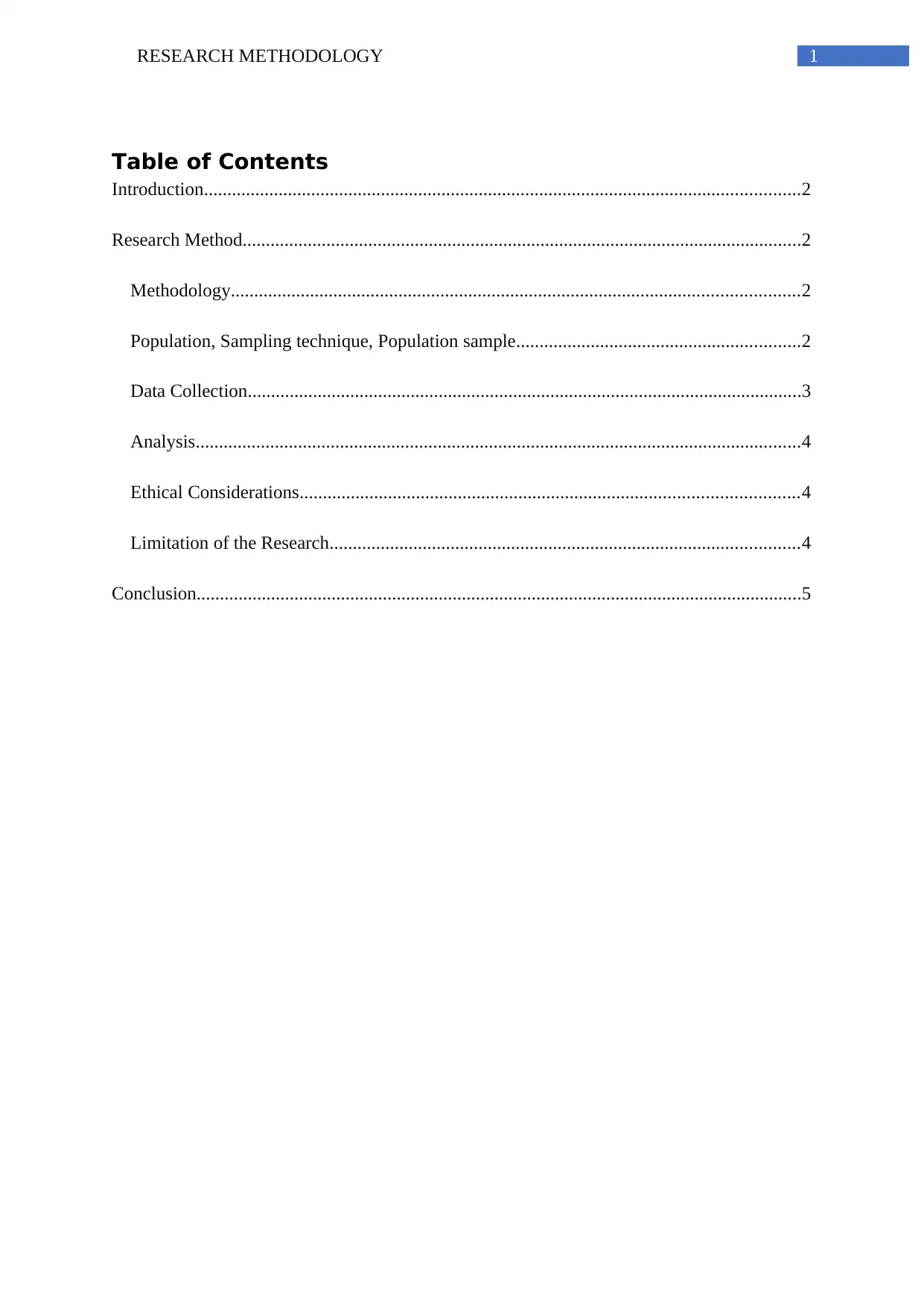
1RESEARCH METHODOLOGY
Table of Contents
Introduction................................................................................................................................2
Research Method........................................................................................................................2
Methodology..........................................................................................................................2
Population, Sampling technique, Population sample.............................................................2
Data Collection.......................................................................................................................3
Analysis..................................................................................................................................4
Ethical Considerations...........................................................................................................4
Limitation of the Research.....................................................................................................4
Conclusion..................................................................................................................................5
Table of Contents
Introduction................................................................................................................................2
Research Method........................................................................................................................2
Methodology..........................................................................................................................2
Population, Sampling technique, Population sample.............................................................2
Data Collection.......................................................................................................................3
Analysis..................................................................................................................................4
Ethical Considerations...........................................................................................................4
Limitation of the Research.....................................................................................................4
Conclusion..................................................................................................................................5
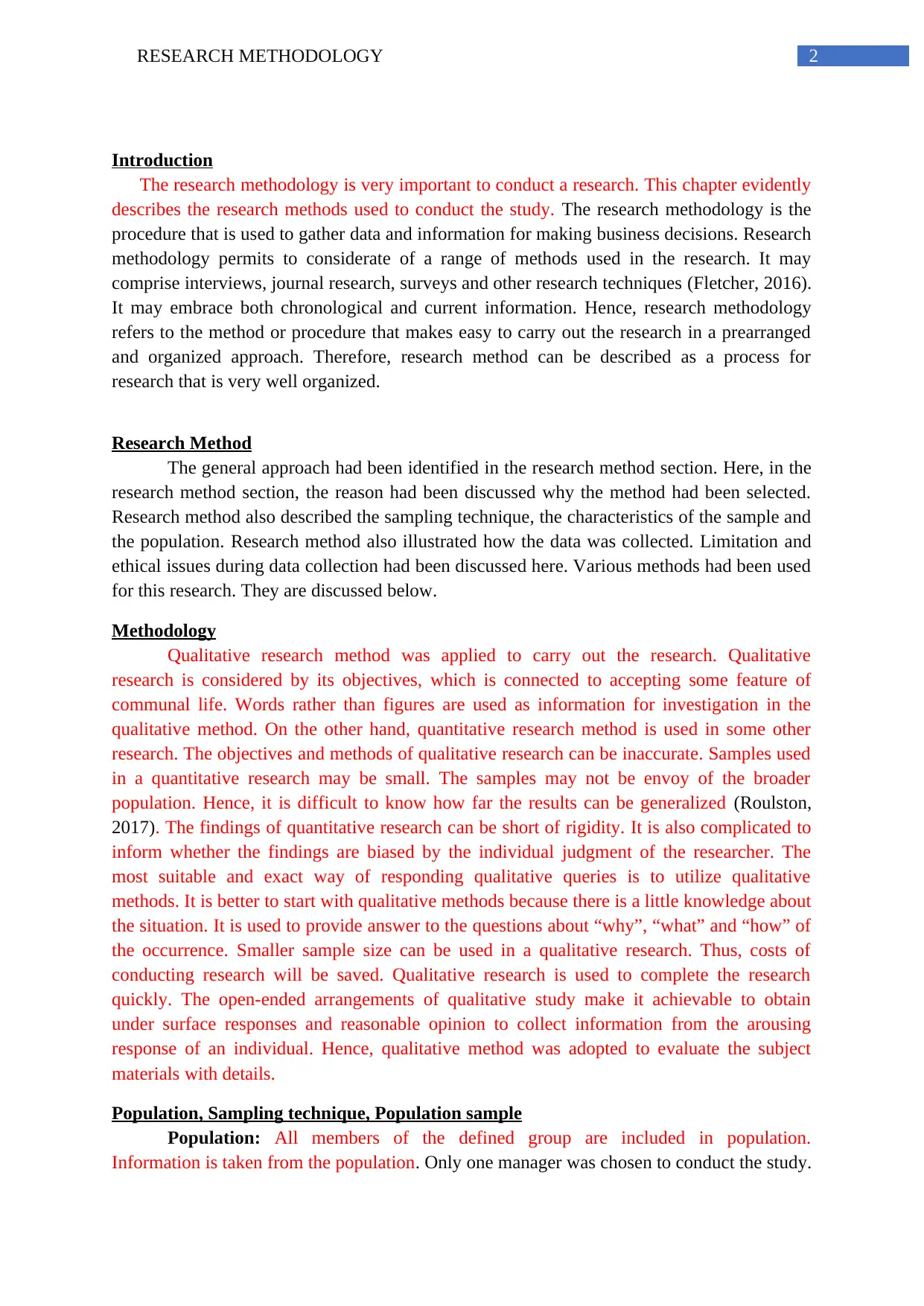
2RESEARCH METHODOLOGY
Introduction
The research methodology is very important to conduct a research. This chapter evidently
describes the research methods used to conduct the study. The research methodology is the
procedure that is used to gather data and information for making business decisions. Research
methodology permits to considerate of a range of methods used in the research. It may
comprise interviews, journal research, surveys and other research techniques (Fletcher, 2016).
It may embrace both chronological and current information. Hence, research methodology
refers to the method or procedure that makes easy to carry out the research in a prearranged
and organized approach. Therefore, research method can be described as a process for
research that is very well organized.
Research Method
The general approach had been identified in the research method section. Here, in the
research method section, the reason had been discussed why the method had been selected.
Research method also described the sampling technique, the characteristics of the sample and
the population. Research method also illustrated how the data was collected. Limitation and
ethical issues during data collection had been discussed here. Various methods had been used
for this research. They are discussed below.
Methodology
Qualitative research method was applied to carry out the research. Qualitative
research is considered by its objectives, which is connected to accepting some feature of
communal life. Words rather than figures are used as information for investigation in the
qualitative method. On the other hand, quantitative research method is used in some other
research. The objectives and methods of qualitative research can be inaccurate. Samples used
in a quantitative research may be small. The samples may not be envoy of the broader
population. Hence, it is difficult to know how far the results can be generalized (Roulston,
2017). The findings of quantitative research can be short of rigidity. It is also complicated to
inform whether the findings are biased by the individual judgment of the researcher. The
most suitable and exact way of responding qualitative queries is to utilize qualitative
methods. It is better to start with qualitative methods because there is a little knowledge about
the situation. It is used to provide answer to the questions about “why”, “what” and “how” of
the occurrence. Smaller sample size can be used in a qualitative research. Thus, costs of
conducting research will be saved. Qualitative research is used to complete the research
quickly. The open-ended arrangements of qualitative study make it achievable to obtain
under surface responses and reasonable opinion to collect information from the arousing
response of an individual. Hence, qualitative method was adopted to evaluate the subject
materials with details.
Population, Sampling technique, Population sample
Population: All members of the defined group are included in population.
Information is taken from the population. Only one manager was chosen to conduct the study.
Introduction
The research methodology is very important to conduct a research. This chapter evidently
describes the research methods used to conduct the study. The research methodology is the
procedure that is used to gather data and information for making business decisions. Research
methodology permits to considerate of a range of methods used in the research. It may
comprise interviews, journal research, surveys and other research techniques (Fletcher, 2016).
It may embrace both chronological and current information. Hence, research methodology
refers to the method or procedure that makes easy to carry out the research in a prearranged
and organized approach. Therefore, research method can be described as a process for
research that is very well organized.
Research Method
The general approach had been identified in the research method section. Here, in the
research method section, the reason had been discussed why the method had been selected.
Research method also described the sampling technique, the characteristics of the sample and
the population. Research method also illustrated how the data was collected. Limitation and
ethical issues during data collection had been discussed here. Various methods had been used
for this research. They are discussed below.
Methodology
Qualitative research method was applied to carry out the research. Qualitative
research is considered by its objectives, which is connected to accepting some feature of
communal life. Words rather than figures are used as information for investigation in the
qualitative method. On the other hand, quantitative research method is used in some other
research. The objectives and methods of qualitative research can be inaccurate. Samples used
in a quantitative research may be small. The samples may not be envoy of the broader
population. Hence, it is difficult to know how far the results can be generalized (Roulston,
2017). The findings of quantitative research can be short of rigidity. It is also complicated to
inform whether the findings are biased by the individual judgment of the researcher. The
most suitable and exact way of responding qualitative queries is to utilize qualitative
methods. It is better to start with qualitative methods because there is a little knowledge about
the situation. It is used to provide answer to the questions about “why”, “what” and “how” of
the occurrence. Smaller sample size can be used in a qualitative research. Thus, costs of
conducting research will be saved. Qualitative research is used to complete the research
quickly. The open-ended arrangements of qualitative study make it achievable to obtain
under surface responses and reasonable opinion to collect information from the arousing
response of an individual. Hence, qualitative method was adopted to evaluate the subject
materials with details.
Population, Sampling technique, Population sample
Population: All members of the defined group are included in population.
Information is taken from the population. Only one manager was chosen to conduct the study.
⊘ This is a preview!⊘
Do you want full access?
Subscribe today to unlock all pages.

Trusted by 1+ million students worldwide
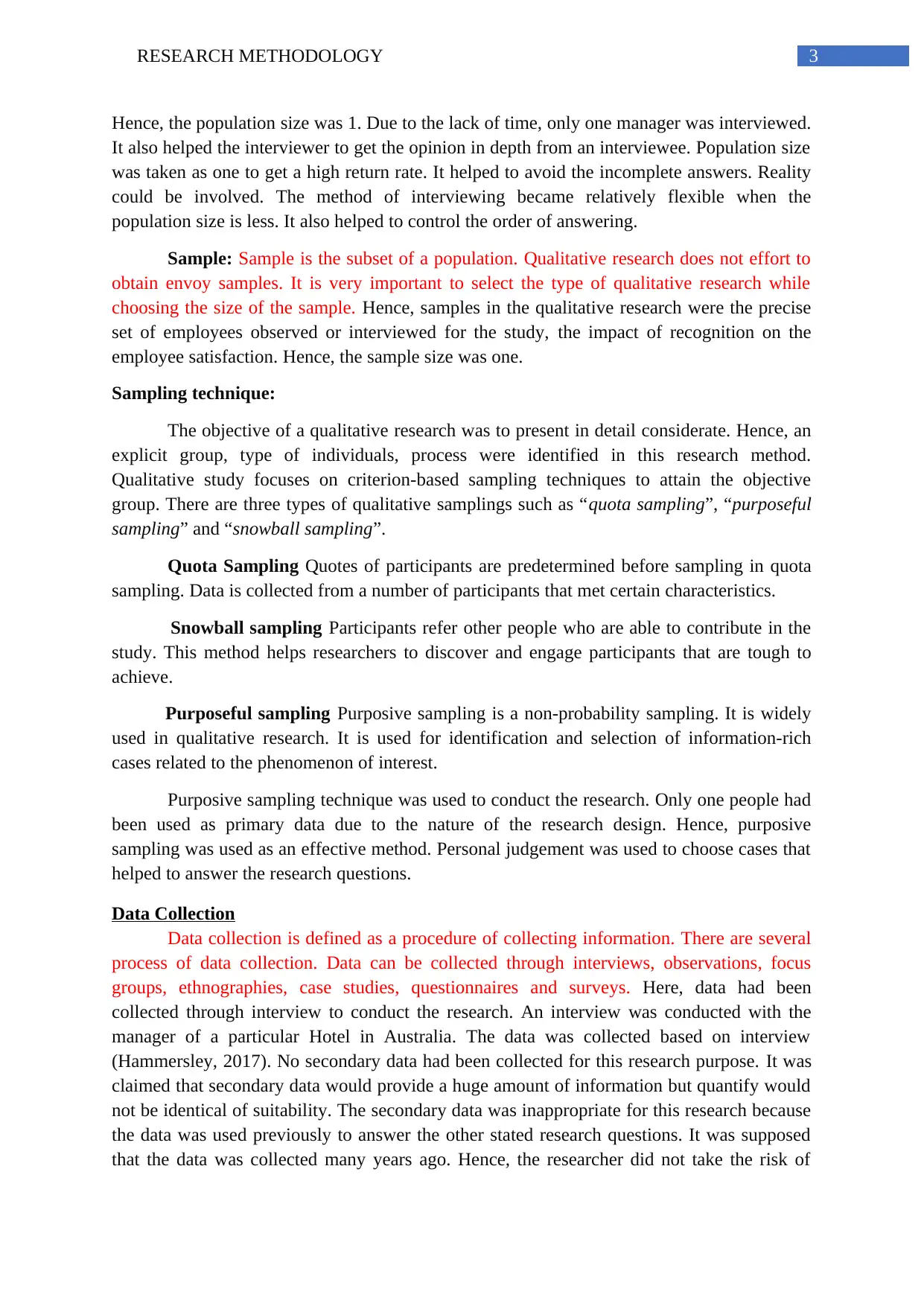
3RESEARCH METHODOLOGY
Hence, the population size was 1. Due to the lack of time, only one manager was interviewed.
It also helped the interviewer to get the opinion in depth from an interviewee. Population size
was taken as one to get a high return rate. It helped to avoid the incomplete answers. Reality
could be involved. The method of interviewing became relatively flexible when the
population size is less. It also helped to control the order of answering.
Sample: Sample is the subset of a population. Qualitative research does not effort to
obtain envoy samples. It is very important to select the type of qualitative research while
choosing the size of the sample. Hence, samples in the qualitative research were the precise
set of employees observed or interviewed for the study, the impact of recognition on the
employee satisfaction. Hence, the sample size was one.
Sampling technique:
The objective of a qualitative research was to present in detail considerate. Hence, an
explicit group, type of individuals, process were identified in this research method.
Qualitative study focuses on criterion-based sampling techniques to attain the objective
group. There are three types of qualitative samplings such as “quota sampling”, “purposeful
sampling” and “snowball sampling”.
Quota Sampling Quotes of participants are predetermined before sampling in quota
sampling. Data is collected from a number of participants that met certain characteristics.
Snowball sampling Participants refer other people who are able to contribute in the
study. This method helps researchers to discover and engage participants that are tough to
achieve.
Purposeful sampling Purposive sampling is a non-probability sampling. It is widely
used in qualitative research. It is used for identification and selection of information-rich
cases related to the phenomenon of interest.
Purposive sampling technique was used to conduct the research. Only one people had
been used as primary data due to the nature of the research design. Hence, purposive
sampling was used as an effective method. Personal judgement was used to choose cases that
helped to answer the research questions.
Data Collection
Data collection is defined as a procedure of collecting information. There are several
process of data collection. Data can be collected through interviews, observations, focus
groups, ethnographies, case studies, questionnaires and surveys. Here, data had been
collected through interview to conduct the research. An interview was conducted with the
manager of a particular Hotel in Australia. The data was collected based on interview
(Hammersley, 2017). No secondary data had been collected for this research purpose. It was
claimed that secondary data would provide a huge amount of information but quantify would
not be identical of suitability. The secondary data was inappropriate for this research because
the data was used previously to answer the other stated research questions. It was supposed
that the data was collected many years ago. Hence, the researcher did not take the risk of
Hence, the population size was 1. Due to the lack of time, only one manager was interviewed.
It also helped the interviewer to get the opinion in depth from an interviewee. Population size
was taken as one to get a high return rate. It helped to avoid the incomplete answers. Reality
could be involved. The method of interviewing became relatively flexible when the
population size is less. It also helped to control the order of answering.
Sample: Sample is the subset of a population. Qualitative research does not effort to
obtain envoy samples. It is very important to select the type of qualitative research while
choosing the size of the sample. Hence, samples in the qualitative research were the precise
set of employees observed or interviewed for the study, the impact of recognition on the
employee satisfaction. Hence, the sample size was one.
Sampling technique:
The objective of a qualitative research was to present in detail considerate. Hence, an
explicit group, type of individuals, process were identified in this research method.
Qualitative study focuses on criterion-based sampling techniques to attain the objective
group. There are three types of qualitative samplings such as “quota sampling”, “purposeful
sampling” and “snowball sampling”.
Quota Sampling Quotes of participants are predetermined before sampling in quota
sampling. Data is collected from a number of participants that met certain characteristics.
Snowball sampling Participants refer other people who are able to contribute in the
study. This method helps researchers to discover and engage participants that are tough to
achieve.
Purposeful sampling Purposive sampling is a non-probability sampling. It is widely
used in qualitative research. It is used for identification and selection of information-rich
cases related to the phenomenon of interest.
Purposive sampling technique was used to conduct the research. Only one people had
been used as primary data due to the nature of the research design. Hence, purposive
sampling was used as an effective method. Personal judgement was used to choose cases that
helped to answer the research questions.
Data Collection
Data collection is defined as a procedure of collecting information. There are several
process of data collection. Data can be collected through interviews, observations, focus
groups, ethnographies, case studies, questionnaires and surveys. Here, data had been
collected through interview to conduct the research. An interview was conducted with the
manager of a particular Hotel in Australia. The data was collected based on interview
(Hammersley, 2017). No secondary data had been collected for this research purpose. It was
claimed that secondary data would provide a huge amount of information but quantify would
not be identical of suitability. The secondary data was inappropriate for this research because
the data was used previously to answer the other stated research questions. It was supposed
that the data was collected many years ago. Hence, the researcher did not take the risk of
Paraphrase This Document
Need a fresh take? Get an instant paraphrase of this document with our AI Paraphraser
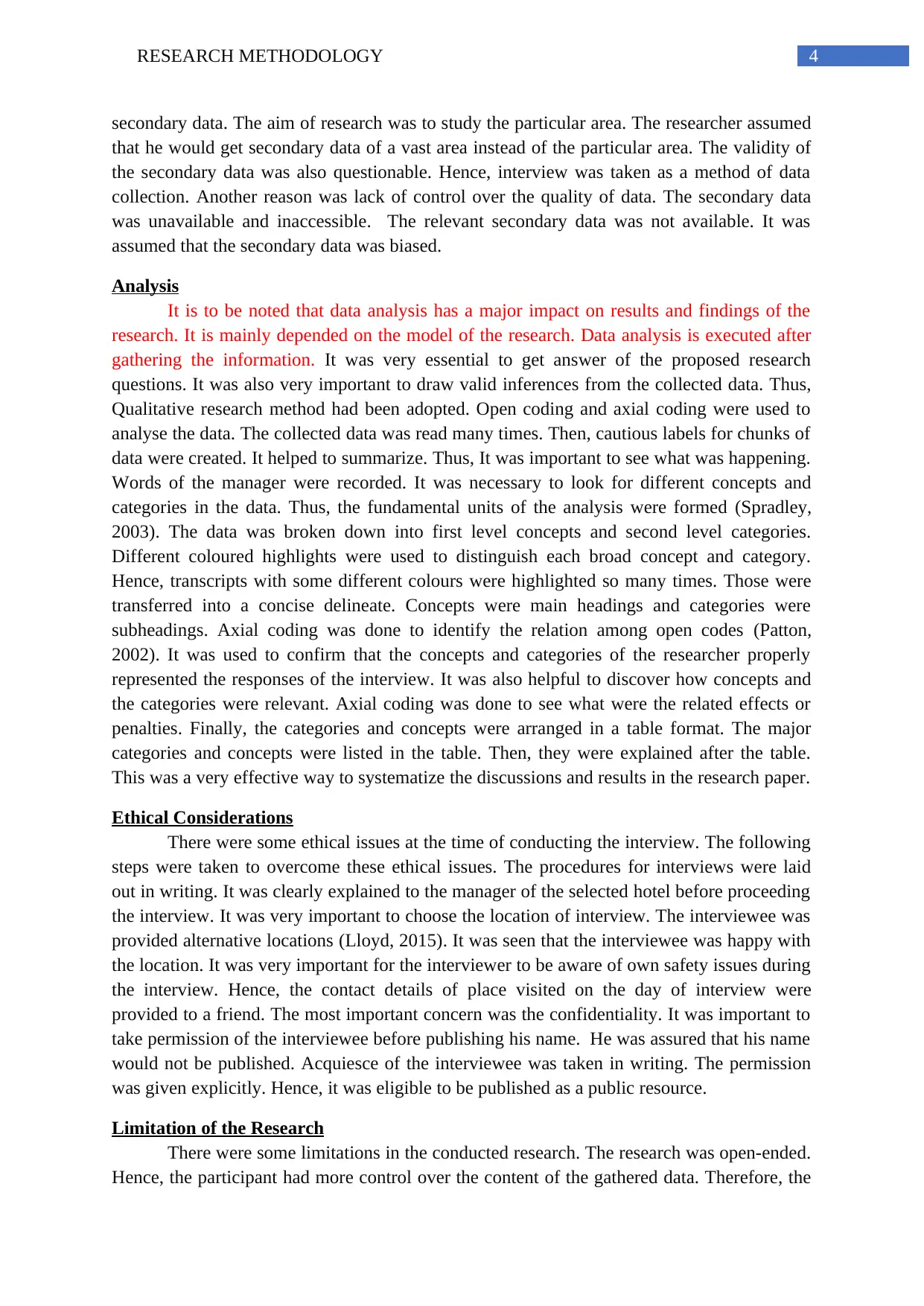
4RESEARCH METHODOLOGY
secondary data. The aim of research was to study the particular area. The researcher assumed
that he would get secondary data of a vast area instead of the particular area. The validity of
the secondary data was also questionable. Hence, interview was taken as a method of data
collection. Another reason was lack of control over the quality of data. The secondary data
was unavailable and inaccessible. The relevant secondary data was not available. It was
assumed that the secondary data was biased.
Analysis
It is to be noted that data analysis has a major impact on results and findings of the
research. It is mainly depended on the model of the research. Data analysis is executed after
gathering the information. It was very essential to get answer of the proposed research
questions. It was also very important to draw valid inferences from the collected data. Thus,
Qualitative research method had been adopted. Open coding and axial coding were used to
analyse the data. The collected data was read many times. Then, cautious labels for chunks of
data were created. It helped to summarize. Thus, It was important to see what was happening.
Words of the manager were recorded. It was necessary to look for different concepts and
categories in the data. Thus, the fundamental units of the analysis were formed (Spradley,
2003). The data was broken down into first level concepts and second level categories.
Different coloured highlights were used to distinguish each broad concept and category.
Hence, transcripts with some different colours were highlighted so many times. Those were
transferred into a concise delineate. Concepts were main headings and categories were
subheadings. Axial coding was done to identify the relation among open codes (Patton,
2002). It was used to confirm that the concepts and categories of the researcher properly
represented the responses of the interview. It was also helpful to discover how concepts and
the categories were relevant. Axial coding was done to see what were the related effects or
penalties. Finally, the categories and concepts were arranged in a table format. The major
categories and concepts were listed in the table. Then, they were explained after the table.
This was a very effective way to systematize the discussions and results in the research paper.
Ethical Considerations
There were some ethical issues at the time of conducting the interview. The following
steps were taken to overcome these ethical issues. The procedures for interviews were laid
out in writing. It was clearly explained to the manager of the selected hotel before proceeding
the interview. It was very important to choose the location of interview. The interviewee was
provided alternative locations (Lloyd, 2015). It was seen that the interviewee was happy with
the location. It was very important for the interviewer to be aware of own safety issues during
the interview. Hence, the contact details of place visited on the day of interview were
provided to a friend. The most important concern was the confidentiality. It was important to
take permission of the interviewee before publishing his name. He was assured that his name
would not be published. Acquiesce of the interviewee was taken in writing. The permission
was given explicitly. Hence, it was eligible to be published as a public resource.
Limitation of the Research
There were some limitations in the conducted research. The research was open-ended.
Hence, the participant had more control over the content of the gathered data. Therefore, the
secondary data. The aim of research was to study the particular area. The researcher assumed
that he would get secondary data of a vast area instead of the particular area. The validity of
the secondary data was also questionable. Hence, interview was taken as a method of data
collection. Another reason was lack of control over the quality of data. The secondary data
was unavailable and inaccessible. The relevant secondary data was not available. It was
assumed that the secondary data was biased.
Analysis
It is to be noted that data analysis has a major impact on results and findings of the
research. It is mainly depended on the model of the research. Data analysis is executed after
gathering the information. It was very essential to get answer of the proposed research
questions. It was also very important to draw valid inferences from the collected data. Thus,
Qualitative research method had been adopted. Open coding and axial coding were used to
analyse the data. The collected data was read many times. Then, cautious labels for chunks of
data were created. It helped to summarize. Thus, It was important to see what was happening.
Words of the manager were recorded. It was necessary to look for different concepts and
categories in the data. Thus, the fundamental units of the analysis were formed (Spradley,
2003). The data was broken down into first level concepts and second level categories.
Different coloured highlights were used to distinguish each broad concept and category.
Hence, transcripts with some different colours were highlighted so many times. Those were
transferred into a concise delineate. Concepts were main headings and categories were
subheadings. Axial coding was done to identify the relation among open codes (Patton,
2002). It was used to confirm that the concepts and categories of the researcher properly
represented the responses of the interview. It was also helpful to discover how concepts and
the categories were relevant. Axial coding was done to see what were the related effects or
penalties. Finally, the categories and concepts were arranged in a table format. The major
categories and concepts were listed in the table. Then, they were explained after the table.
This was a very effective way to systematize the discussions and results in the research paper.
Ethical Considerations
There were some ethical issues at the time of conducting the interview. The following
steps were taken to overcome these ethical issues. The procedures for interviews were laid
out in writing. It was clearly explained to the manager of the selected hotel before proceeding
the interview. It was very important to choose the location of interview. The interviewee was
provided alternative locations (Lloyd, 2015). It was seen that the interviewee was happy with
the location. It was very important for the interviewer to be aware of own safety issues during
the interview. Hence, the contact details of place visited on the day of interview were
provided to a friend. The most important concern was the confidentiality. It was important to
take permission of the interviewee before publishing his name. He was assured that his name
would not be published. Acquiesce of the interviewee was taken in writing. The permission
was given explicitly. Hence, it was eligible to be published as a public resource.
Limitation of the Research
There were some limitations in the conducted research. The research was open-ended.
Hence, the participant had more control over the content of the gathered data. Therefore, the
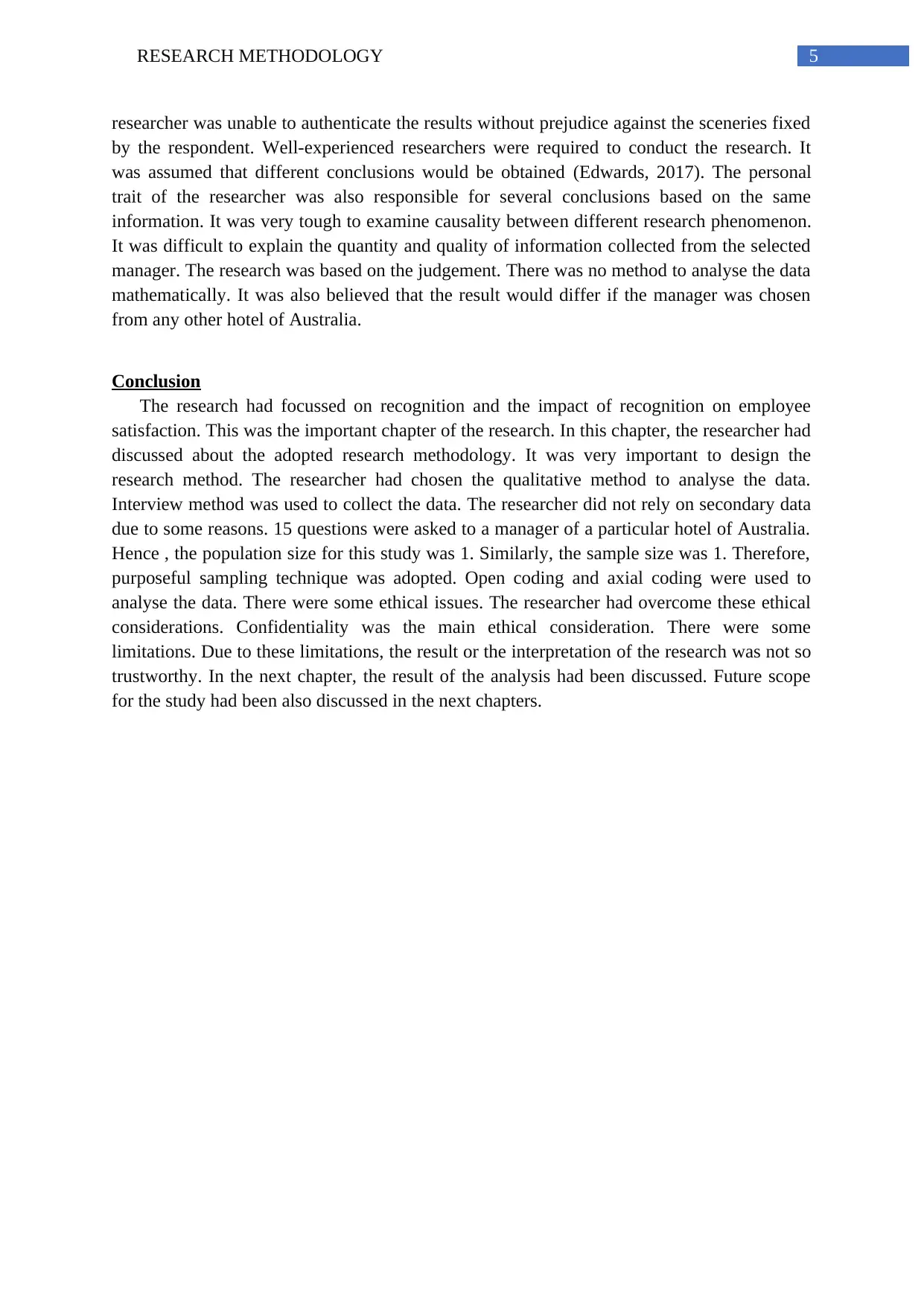
5RESEARCH METHODOLOGY
researcher was unable to authenticate the results without prejudice against the sceneries fixed
by the respondent. Well-experienced researchers were required to conduct the research. It
was assumed that different conclusions would be obtained (Edwards, 2017). The personal
trait of the researcher was also responsible for several conclusions based on the same
information. It was very tough to examine causality between different research phenomenon.
It was difficult to explain the quantity and quality of information collected from the selected
manager. The research was based on the judgement. There was no method to analyse the data
mathematically. It was also believed that the result would differ if the manager was chosen
from any other hotel of Australia.
Conclusion
The research had focussed on recognition and the impact of recognition on employee
satisfaction. This was the important chapter of the research. In this chapter, the researcher had
discussed about the adopted research methodology. It was very important to design the
research method. The researcher had chosen the qualitative method to analyse the data.
Interview method was used to collect the data. The researcher did not rely on secondary data
due to some reasons. 15 questions were asked to a manager of a particular hotel of Australia.
Hence , the population size for this study was 1. Similarly, the sample size was 1. Therefore,
purposeful sampling technique was adopted. Open coding and axial coding were used to
analyse the data. There were some ethical issues. The researcher had overcome these ethical
considerations. Confidentiality was the main ethical consideration. There were some
limitations. Due to these limitations, the result or the interpretation of the research was not so
trustworthy. In the next chapter, the result of the analysis had been discussed. Future scope
for the study had been also discussed in the next chapters.
researcher was unable to authenticate the results without prejudice against the sceneries fixed
by the respondent. Well-experienced researchers were required to conduct the research. It
was assumed that different conclusions would be obtained (Edwards, 2017). The personal
trait of the researcher was also responsible for several conclusions based on the same
information. It was very tough to examine causality between different research phenomenon.
It was difficult to explain the quantity and quality of information collected from the selected
manager. The research was based on the judgement. There was no method to analyse the data
mathematically. It was also believed that the result would differ if the manager was chosen
from any other hotel of Australia.
Conclusion
The research had focussed on recognition and the impact of recognition on employee
satisfaction. This was the important chapter of the research. In this chapter, the researcher had
discussed about the adopted research methodology. It was very important to design the
research method. The researcher had chosen the qualitative method to analyse the data.
Interview method was used to collect the data. The researcher did not rely on secondary data
due to some reasons. 15 questions were asked to a manager of a particular hotel of Australia.
Hence , the population size for this study was 1. Similarly, the sample size was 1. Therefore,
purposeful sampling technique was adopted. Open coding and axial coding were used to
analyse the data. There were some ethical issues. The researcher had overcome these ethical
considerations. Confidentiality was the main ethical consideration. There were some
limitations. Due to these limitations, the result or the interpretation of the research was not so
trustworthy. In the next chapter, the result of the analysis had been discussed. Future scope
for the study had been also discussed in the next chapters.
⊘ This is a preview!⊘
Do you want full access?
Subscribe today to unlock all pages.

Trusted by 1+ million students worldwide
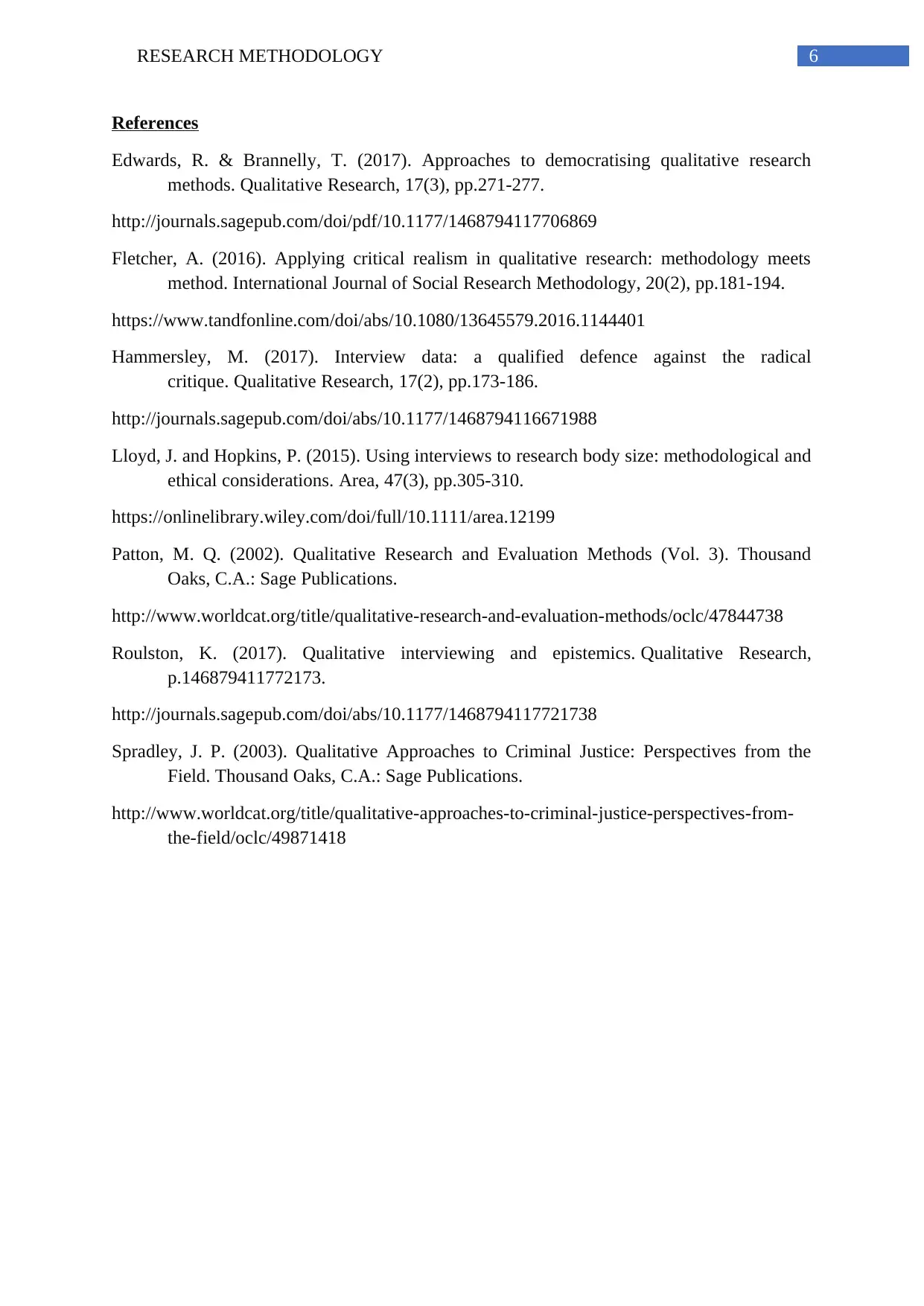
6RESEARCH METHODOLOGY
References
Edwards, R. & Brannelly, T. (2017). Approaches to democratising qualitative research
methods. Qualitative Research, 17(3), pp.271-277.
http://journals.sagepub.com/doi/pdf/10.1177/1468794117706869
Fletcher, A. (2016). Applying critical realism in qualitative research: methodology meets
method. International Journal of Social Research Methodology, 20(2), pp.181-194.
https://www.tandfonline.com/doi/abs/10.1080/13645579.2016.1144401
Hammersley, M. (2017). Interview data: a qualified defence against the radical
critique. Qualitative Research, 17(2), pp.173-186.
http://journals.sagepub.com/doi/abs/10.1177/1468794116671988
Lloyd, J. and Hopkins, P. (2015). Using interviews to research body size: methodological and
ethical considerations. Area, 47(3), pp.305-310.
https://onlinelibrary.wiley.com/doi/full/10.1111/area.12199
Patton, M. Q. (2002). Qualitative Research and Evaluation Methods (Vol. 3). Thousand
Oaks, C.A.: Sage Publications.
http://www.worldcat.org/title/qualitative-research-and-evaluation-methods/oclc/47844738
Roulston, K. (2017). Qualitative interviewing and epistemics. Qualitative Research,
p.146879411772173.
http://journals.sagepub.com/doi/abs/10.1177/1468794117721738
Spradley, J. P. (2003). Qualitative Approaches to Criminal Justice: Perspectives from the
Field. Thousand Oaks, C.A.: Sage Publications.
http://www.worldcat.org/title/qualitative-approaches-to-criminal-justice-perspectives-from-
the-field/oclc/49871418
References
Edwards, R. & Brannelly, T. (2017). Approaches to democratising qualitative research
methods. Qualitative Research, 17(3), pp.271-277.
http://journals.sagepub.com/doi/pdf/10.1177/1468794117706869
Fletcher, A. (2016). Applying critical realism in qualitative research: methodology meets
method. International Journal of Social Research Methodology, 20(2), pp.181-194.
https://www.tandfonline.com/doi/abs/10.1080/13645579.2016.1144401
Hammersley, M. (2017). Interview data: a qualified defence against the radical
critique. Qualitative Research, 17(2), pp.173-186.
http://journals.sagepub.com/doi/abs/10.1177/1468794116671988
Lloyd, J. and Hopkins, P. (2015). Using interviews to research body size: methodological and
ethical considerations. Area, 47(3), pp.305-310.
https://onlinelibrary.wiley.com/doi/full/10.1111/area.12199
Patton, M. Q. (2002). Qualitative Research and Evaluation Methods (Vol. 3). Thousand
Oaks, C.A.: Sage Publications.
http://www.worldcat.org/title/qualitative-research-and-evaluation-methods/oclc/47844738
Roulston, K. (2017). Qualitative interviewing and epistemics. Qualitative Research,
p.146879411772173.
http://journals.sagepub.com/doi/abs/10.1177/1468794117721738
Spradley, J. P. (2003). Qualitative Approaches to Criminal Justice: Perspectives from the
Field. Thousand Oaks, C.A.: Sage Publications.
http://www.worldcat.org/title/qualitative-approaches-to-criminal-justice-perspectives-from-
the-field/oclc/49871418
Paraphrase This Document
Need a fresh take? Get an instant paraphrase of this document with our AI Paraphraser
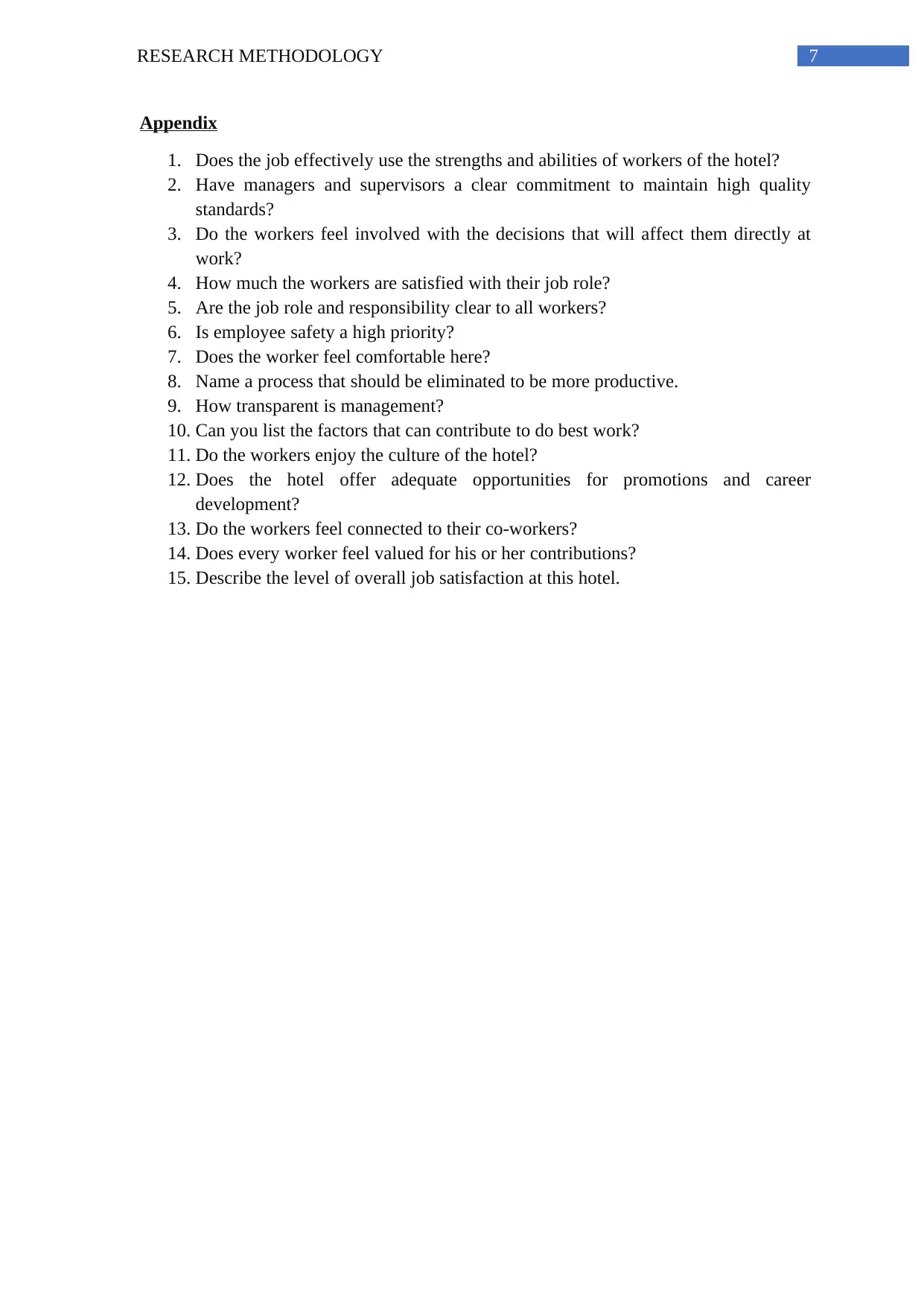
7RESEARCH METHODOLOGY
Appendix
1. Does the job effectively use the strengths and abilities of workers of the hotel?
2. Have managers and supervisors a clear commitment to maintain high quality
standards?
3. Do the workers feel involved with the decisions that will affect them directly at
work?
4. How much the workers are satisfied with their job role?
5. Are the job role and responsibility clear to all workers?
6. Is employee safety a high priority?
7. Does the worker feel comfortable here?
8. Name a process that should be eliminated to be more productive.
9. How transparent is management?
10. Can you list the factors that can contribute to do best work?
11. Do the workers enjoy the culture of the hotel?
12. Does the hotel offer adequate opportunities for promotions and career
development?
13. Do the workers feel connected to their co-workers?
14. Does every worker feel valued for his or her contributions?
15. Describe the level of overall job satisfaction at this hotel.
Appendix
1. Does the job effectively use the strengths and abilities of workers of the hotel?
2. Have managers and supervisors a clear commitment to maintain high quality
standards?
3. Do the workers feel involved with the decisions that will affect them directly at
work?
4. How much the workers are satisfied with their job role?
5. Are the job role and responsibility clear to all workers?
6. Is employee safety a high priority?
7. Does the worker feel comfortable here?
8. Name a process that should be eliminated to be more productive.
9. How transparent is management?
10. Can you list the factors that can contribute to do best work?
11. Do the workers enjoy the culture of the hotel?
12. Does the hotel offer adequate opportunities for promotions and career
development?
13. Do the workers feel connected to their co-workers?
14. Does every worker feel valued for his or her contributions?
15. Describe the level of overall job satisfaction at this hotel.
1 out of 8
Related Documents
Your All-in-One AI-Powered Toolkit for Academic Success.
+13062052269
info@desklib.com
Available 24*7 on WhatsApp / Email
![[object Object]](/_next/static/media/star-bottom.7253800d.svg)
Unlock your academic potential
Copyright © 2020–2025 A2Z Services. All Rights Reserved. Developed and managed by ZUCOL.





